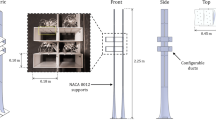Abstract
The behavior of a bubble blood oxygenator is simulated by a dispersion model. The model equations are solved by both a variable step size-finite difference algorithm and a backward marching technique. The computed results indicate that blood oxygen saturation increases with increases in column diameter and glas flow rate. The bubble column is found to behave like a continuously stirred tank reactor at large values of either the column diameter or the gas flow rate. The performance of Shiley and Harvey H-200 bubble oxygenators was compared with the dispersion model. The results were found to be in good agreement.
Similar content being viewed by others
References
Akita, K. Dr. Erg. Thesis, Kyoto University, Japan, 1973.
Akita, K. and F. Yoshida. Gas hold-up and volumetric mass transfer coefficient in bubble columns: Effect of liquid properties.Ind. Eng. Chem., Process Des. Dev. 12:76–80, 1973.
Akita, K. and F. Yoshida. Bubble size, interfacial area and liquid — phase mass transfer coefficient in bubble columns.Ind. Eng. Chem., Process Des. Dev. 13:84–91, 1974.
Arunachalam, V.M., Ph.D. thesis. Indian Institute of Technology, Madras, India, 1979.
Bergdahl, L. and V.O. Björk. Optimal gas flow in new Shiley bubble oxygenator.Scand. J. Thor. Cardiovasc. Surg. 12:55–57, 1972.
Björk, V.O., L. Bergdahl, and C. Wussow. Gas flow in relation to blood flow in oxygenators. An evaluation of the new Shiley bubble oxygenator.Scan. J. Thor. Cardiovasc. Surg. 71:422–425, 1977.
Buckles, R.G., E.W. Merrill, and E.R. Gilliland. An analysis of oxygen absorption in tubular membrane oxygenator.AIChE J. 14:703–708, 1968.
Cantekin, E.I. and M.H. Weissman. Experimental and theoretical considerations in augmenting oxygen transfer in membrane artificial lungs.Med. Biol. Eng. Comput. 13:617–630, 1975.
Colton, C.K. and R.F. Drake. Effect of boundary conditions on oxygen transport to blood flowing in a tube.Chem. Eng. Prog., Symp. Ser. 67:88–95, 1971.
Danckwerts, P.V. Significance of liquid film coefficients in gas absorption.Ind. Eng. Chem. 43:1460–1467, 1951.
Deckwar, W.D. Non-isobaric bubble columns with variable gas velocity. Chem. Eng. Sci. 31:309–317, 1976.
Eissa, S.H., M.M. El-Halwagi, and M.A. Saleh. Axial and radial mixing in a cocurrent bubble column.Ind. Eng. Chem., Process Des. Dev. 10:31–36, 1971.
Kolobow, T. and W.M. Zapol. Partial and total extracorporeal respiratory gas exchange with spiral membrane lung.Adv. Cardiol. 6:112–116, 1971.
Lande, A.J., S.J. Sillmore, V. Subramanian, R.N. Tiedman, and R.G. Carlson. 24 hours venous arterial perfusion of awake dog with a simple membrane oxygenator.Trans. Am. Soc. Artif. Inter. Organs 15:181–184, 1969.
Mockros, L.F. and M.H. Weissman. The artificial lung. In:Biomedical Engineering, edited by J.H.V. Brown, J.E. Jacobs and L. Stark, Philadelphia: F.A. Davis, Co., 1971.
Schultz, D.H., V.L. Shah, W. Shay, and P. Wang. Diffusion of oxygen and carbon dioxide through blood flowing in a channel.Med. Biol. Eng. Comput. 15, 98–105, 1977.
Shridharan, K. and Sharma, M.M. New systems and methods for the measurement of effective interfacial area on mass transfer coefficients.Chem. Eng. Sci., 31:767–774, 1976.
Simmons, E., C. MaGuire, E. Lichti, W. Helvey, and C. Almond. A comparison of microparticles produced when two disposable bag oxygenators and a disc oxygenator are used for cardiopulmonary bypass.J. Thorac. Cardiovasc. Surg. 63:613, 1972.
Szeri, A., Y.T. Shah, and A. Madgavker. Axial dispersion in two-phase cocurrent flow with fast and instantaneous reactions.Chem. Eng. Sci. 31:225–233, 1976.
Weissman, M.H. Diffusion in membrane limited blood oxygenators.AIChE J. 15:627–631, 1969.
Weissman, M.H. and T.K. Hung. Numerical Solution of Convective Diffusion in Blood Flowing in a Channel with a Steady Three Dimensional Velocity Field.AIChE J. 17:25–30, 1971.
Weissman, M.H. and L.F. Mockros. Oxygen transfer to blood flowing in round tubes.Proc. Am. Soc. Civ. Eng., Journal of Engineering Mechanics Division. 93:EM6, 225–244, 1967.
Welleck, R.M. and T. Gurkan. Mass transfer in dispersed and continuous phases for creeping flow of fluid spheres through power law fluids.Ind. Eng. Chem. Fundam. 15, 45–52, 1976.
Welleck, R.M. and T. Gurkan. Mass transfer to drops moving through power-law fluids in the intermediate Reynolds number region.AIChE J. 22:484–490, 1977.
Author information
Authors and Affiliations
Rights and permissions
About this article
Cite this article
Arunachalam, V.M., Shettigar, U.R. Bubble blood oxygenator — A a design analysis. Ann Biomed Eng 9, 75–87 (1981). https://doi.org/10.1007/BF02584559
Issue Date:
DOI: https://doi.org/10.1007/BF02584559



